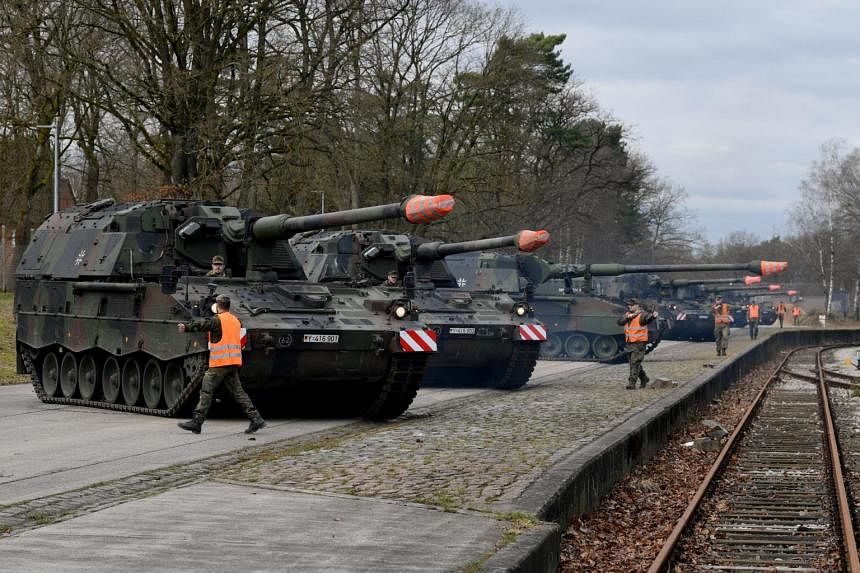BERLIN (BLOOMBERG) - Several North Atlantic Treaty Organisation (Nato) members are looking to Germany for cues as they think about how to boost the alliance's eastern defences against Russia.
The allies are considering adapting a new German model in their long-term defence planning amid tensions over Russia's invasion of Ukraine, according to people familiar with the issue.
Germany's plan involves identifying units that can be deployed to Lithuania at short notice, and link with German and allied troops already on the ground, as well as placing key equipment ahead of time.
The approach would be an alternative to basing new troops more permanently in the most vulnerable member states. Lithuania is among the Baltic nations that have made urgent requests for more troops.
Nato countries have significantly stepped up deployments of troops, jets and ships on the alliance's eastern border since Russia's invasion.
Now, Nato is looking to fortify military formations for the future to deter any potential Russian attacks beyond Ukraine, although there is no sign that President Vladimir Putin has the capacity or will to go farther for now.
Asked whether Germany's plan could be a model for other countries, Defence Minister Christine Lambrecht said on Thursday (June 16) that is what Germany is proposing, adding that the option would be discussed with partners.
"We stand by the allies at the eastern flank and this could also be a possibility for other countries to show their presence and support," Ms Lambrecht told reporters as she arrived for a second day of talks with Nato defence ministers in Brussels.
The ministers are discussing draft plans that would amount to some of the most significant posture changes since the Cold War.
Leaders are due to sign off on the plans in late June in Madrid.
Under a proposal announced by Chancellor Olaf Scholz last week, Germany pledged more military support to Lithuania, where it already leads a multinational Nato battle group, with the possibility of scaling up to a brigade in case of any threats.
Germany would establish a headquarters with equipment, while more soldiers would be present for training in Lithuania but on a rotating basis.
Meanwhile, the bulk of the new troops would be stationed in Germany.
While different countries have different needs and military systems, the German plan could be loosely replicated by other countries, including by Britain in Estonia and by France in Romania, said the people who asked not to be named discussing confidential matters.
The formations would not be precisely the same in every country on the eastern flank, but "in several countries, I expect this to be brigade-size formations based on partly forward presence and partly forward-deployed equipment, and partly preassigned forces", Nato Secretary-General Jens Stoltenberg told reporters on Wednesday.
'Tripwire'
Nato has already established eight battle groups in Poland and the Baltic nations and more recently, Hungary, Slovakia, Bulgaria and Romania, to serve as a so-called "tripwire" in the case of a Russian attack.
Those troops have been regularly rotated out in order to comply with the Nato-Russia Founding Act, signed in 1997 to declare mutual commitments to peace in Europe.
But Russia has repeatedly violated the agreement by not respecting countries' borders so that should not limit Nato's ability to increase its presence in the east, Mr Stoltenberg said.
The tripwire model is also no longer sufficient, Nato officials said.
Along with boosting the number of forces, allies are also expected to agree to position more equipment and supplies in the east, as well as deploy significant numbers of combat ships and more jets, and to strengthen the group's air and missile and cyber defences.
While no final decision has been taken yet, France is preparing something similar to Germany in terms of troop volumes for long-term defence in Romania, according to a person familiar with the matter.
French forces deployed in Romania could be quickly reinforced with other troops based in France.
The German proposal, however, falls short of previous demands by Baltic nations, which directly border Russian territory and have long been concerned about Russian aggression.
They have sought a permanent presence of a significant number of troops that could counter an attack immediately.
'Weaker' deterrent
Rotating troops is a somewhat "weaker" deterrent than having permanent troops stationed in the Baltic states, according to Dr Anna Wieslander, director for Northern Europe at the Atlantic Council think-tank.
She said this also creates a security dilemma that could risk further escalation.
"If you don't have the troops there, at what point do you decide to reinforce?" Dr Wieslander said.
"That's a difficult calculation, and that's the big risk from the deterrence perspective."
Nato officials said the overall military plans will need to be able to scale up and down, for instance, if Russian forces manage to capture more of Ukraine's territory and thereby butt up against more of Nato's borders.
Sweden and Finland's potential memberships, currently held up by Turkey over security concerns, could also impact how the alliance defends its eastern border.
Some allies, including Turkey, have pushed back against deploying too many resources in the Baltics, arguing that the alliance should not forget about the threat of terrorism.
Ankara has reservations on the posture demands because it does not see Russia opening new fronts at a time when it is engaged in Ukraine, Turkish officials said.

